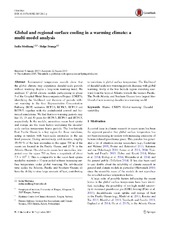| dc.description.abstract | Instrumental temperature records show that the global climate may experience decadal-scale periods without warming despite a long-term warming trend. We analysed 17 global climate models participating in phase 5 of the Coupled Model Intercomparison Project (CMIP5), identifying the likelihood and duration of periods without warming in the four Representative Concentration Pathway (RCP) scenarios RCP2.6, RCP4.5, RCP6.0 and RCP8.5, together with the preindustrial control and historical simulations. We find that non-warming periods may last 10, 15 and 30 years for RCP8.5, RCP6.0 and RCP4.5, respectively. In the models, anomalous ocean heat uptake and storage are the main factors explaining the decadal-scale surface temperature hiatus periods. The low-latitude East Pacific Ocean is a key region for these variations, acting in tandem with basin-scale anomalies in the sea level pressure. During anomalously cold decades, roughly 35–50 % of the heat anomalies in the upper 700 m of the ocean are located in the Pacific Ocean, and 25 % in the Atlantic Ocean. Decadal-scale ocean heat anomalies, integrated over the upper 700 m, have a magnitude of about 7.5 × 1021 J. This is comparable to the ocean heat uptake needed to maintain a 10 year period without increasing surface temperature under global warming. On sub-decadal time scales the Atlantic, Pacific and Southern Oceans all have the ability to store large amounts of heat, contributing to variations in global surface temperature. The likelihood of decadal-scale non-warming periods decrease with global warming, firstly at the low latitude region stretching eastward from the tropical Atlantic towards the western Pacific. The North Atlantic and Southern Oceans have largest likelihood of non-warming decades in a warming world. | en_US |

